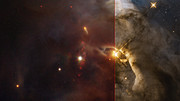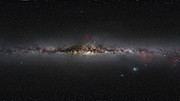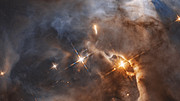A billowing pair of nearly symmetrical loops of dust and gas mark the death throes of an ancient red-giant star, as captured by Gemini South, one half of the International Gemini Observatory, operated by NSF’s NOIRLab. The resulting structure, said to resemble an old style of English jug, is a rarely seen bipolar reflection nebula. Evidence suggests that this object formed by the interactions between the dying red giant and a now-shredded companion star. The image was obtained by NOIRLab’s Communication, Education & Engagement team as part of the NOIRLab Legacy Imaging Program.Credit: International Gemini Observatory/NOIRLab/NSF/AURA Image processing: T.A. Rector (University of Alaska Anchorage/NSF’s NOIRLab), J. Miller (Gemini Observatory/NSF’s NOIRLab), M. Rodriguez (Gemini Observatory/NSF’s NOIRLab), M. Zamani (NSF’s NOIRLab), download: Large JPEG
Gemini South captures the spectacular end-of-life display of a red-giant star
A billowing pair of nearly symmetrical loops of dust and gas
mark the death throes of an ancient red-giant star, as captured by
Gemini South, one half of the International Gemini Observatory, operated
by NSF’s NOIRLab. The resulting structure, said to resemble an old
style of English jug, is a rarely seen bipolar reflection nebula.
Evidence suggests that this object formed by the interactions between
the dying red giant and a now-shredded companion star.
The glowing nebula IC 2220, nicknamed the Toby Jug Nebula owing to its resemblance to an old English drinking vessel, is a rare astronomical find. This reflection nebula, located about 1200 light-years away in the direction of the constellation Carina (the keel), is a double-lobed, or bipolar, cloud of gas and dust created and illuminated by the red-giant star
at its center. This end-of-life phase of red giant stars is relatively
brief, and the celestial structures that form around them are rare,
making the Toby Jug Nebula an excellent case study into stellar
evolution.
This image, captured by the Gemini South telescope, one half of the International Gemini Observatory,
operated by NSF’s NOIRLab, showcases the Toby Jug Nebula’s magnificent,
nearly symmetrical double-looped structure and glowing stellar heart.
These features are unique to red giants transitioning from aging stars
to planetary nebulae
[1] and therefore offer astronomers valuable insight into the evolution
of low- to intermediate-mass stars nearing the end of their lives as
well as the cosmic structures they form.
At the heart of the Toby Jug Nebula is its progenitor, the red-giant
star HR3126. Red giants form when a star burns through its supply of
hydrogen in its core. Without the outward force of fusion, the star
begins to contract. This raises the core temperature and causes the star
to then swell up to 400 times its original size. Though HR3126 is
considerably younger than our Sun — a mere 50 million years old compared
to the Sun’s 4.6 billion years — it is five times the mass. This
allowed the star to burn through its hydrogen supply and become a red
giant much faster than the Sun.
As HR 3126 swelled, its atmosphere expanded and it began to shed its
outer layers. The expelled stellar material flowed out into the
surrounding area, forming a magnificent structure of gas and dust that
reflects the light from the central star. Detailed studies of the Toby
Jug Nebula in infrared light have revealed that silicon dioxide (silica)
is the most likely compound reflecting HR3126’s light.
Astronomers theorize that bipolar structures similar to those seen in
the Toby Jug Nebula are the result of interactions between the central
red giant and a binary companion star. Previous observations, however,
found no such companion to HR3126. Instead, astronomers observed an
extremely compact disk of material around the central star. This finding
suggests that a former binary companion was possibly shredded into the
disk, which may have triggered the formation of the surrounding nebula.
In about five billion years from now, when our Sun has burned through
its supply of hydrogen, it too will become a red giant and eventually
evolve into a planetary nebula. In the very distant future, all that
will be left of our Solar System will be a nebula as vibrant as the Toby
Jug Nebula with the slowly cooling Sun at its heart.
The image was processed by NOIRLab’s Communication, Education & Engagement team as part of the NOIRLab Legacy Imaging Program.
The observations were made with Gemini South on Cerro Pachón in Chile
using one of the dual Gemini Multi-Object Spectrographs (GMOS).
Though spectrographs are designed to split light into various
wavelengths for study, the GMOS spectrographs also have powerful imaging
capabilities, as demonstrated by this exceptional view of the Toby Jug
Nebula.
Notes
[1] The term “planetary nebulae” is a misnomer; they
are unrelated to planets. The term was likely first used in the 1780s
by astronomer William Herschel, who noted their seemingly round,
planet-like shape when observed through early telescopes.
NSF’s NOIRLab (National
Optical-Infrared Astronomy Research Laboratory), the US center for
ground-based optical-infrared astronomy, operates the international Gemini Observatory (a facility of NSF, NRC–Canada, ANID–Chile, MCTIC–Brazil, MINCyT–Argentina, and KASI–Republic of Korea), Kitt Peak National Observatory (KPNO), Cerro Tololo Inter-American Observatory (CTIO), the Community Science and Data Center (CSDC), and Vera C. Rubin Observatory (operated in cooperation with the Department of Energy’s SLAC National Accelerator Laboratory). It is managed by the Association of Universities for Research in Astronomy (AURA)
under a cooperative agreement with NSF and is headquartered in Tucson,
Arizona. The astronomical community is honored to have the opportunity
to conduct astronomical research on Iolkam Du’ag (Kitt Peak) in Arizona,
on Maunakea in Hawai‘i, and on Cerro Tololo and Cerro Pachón in Chile.
We recognize and acknowledge the very significant cultural role and
reverence that these sites have to the Tohono O'odham Nation, to the
Native Hawaiian community, and to the local communities in Chile,
respectively.
Links






























